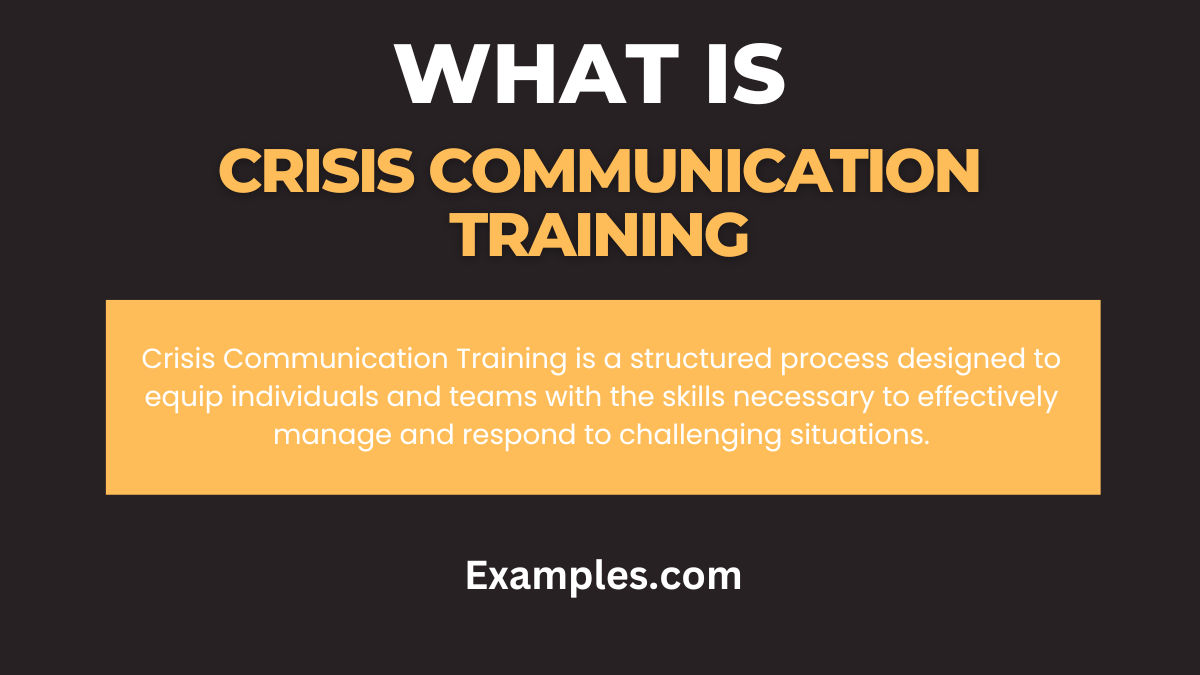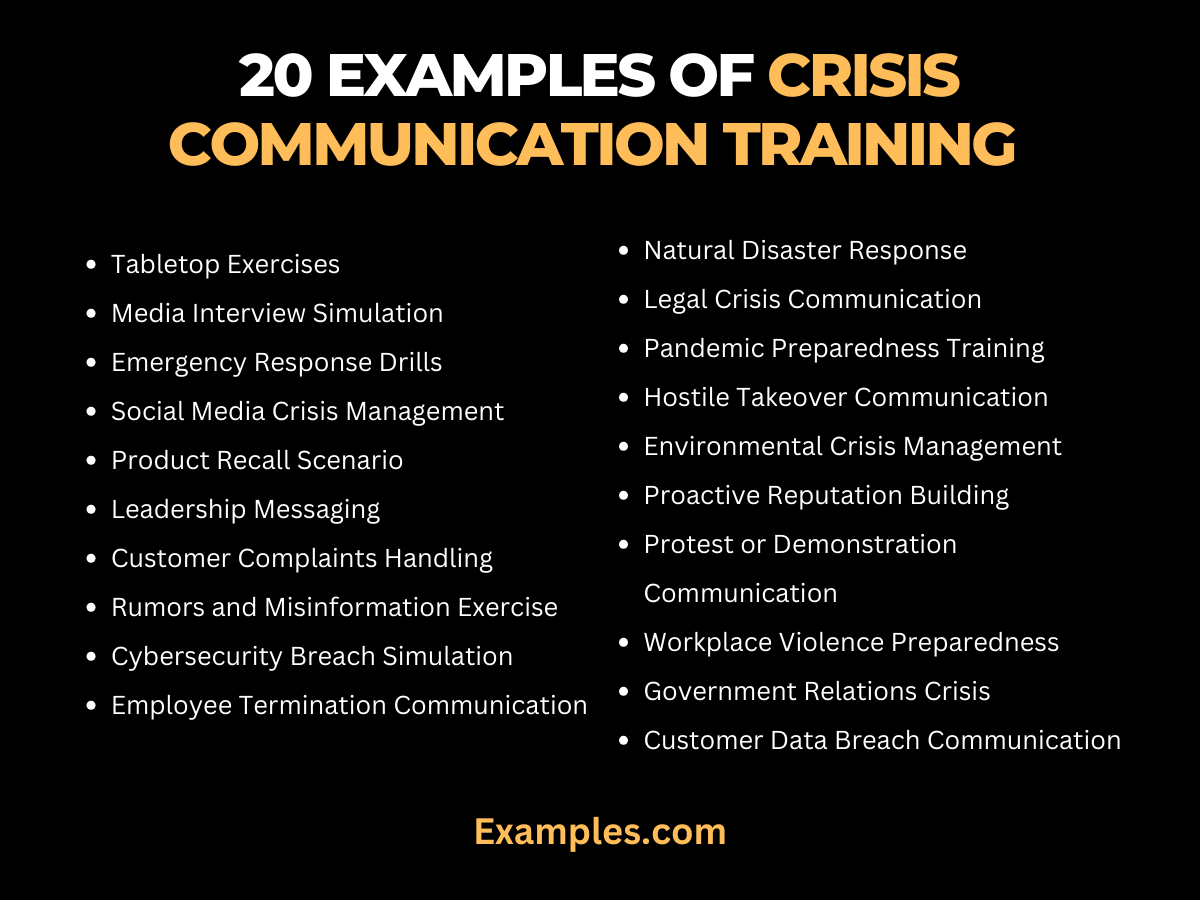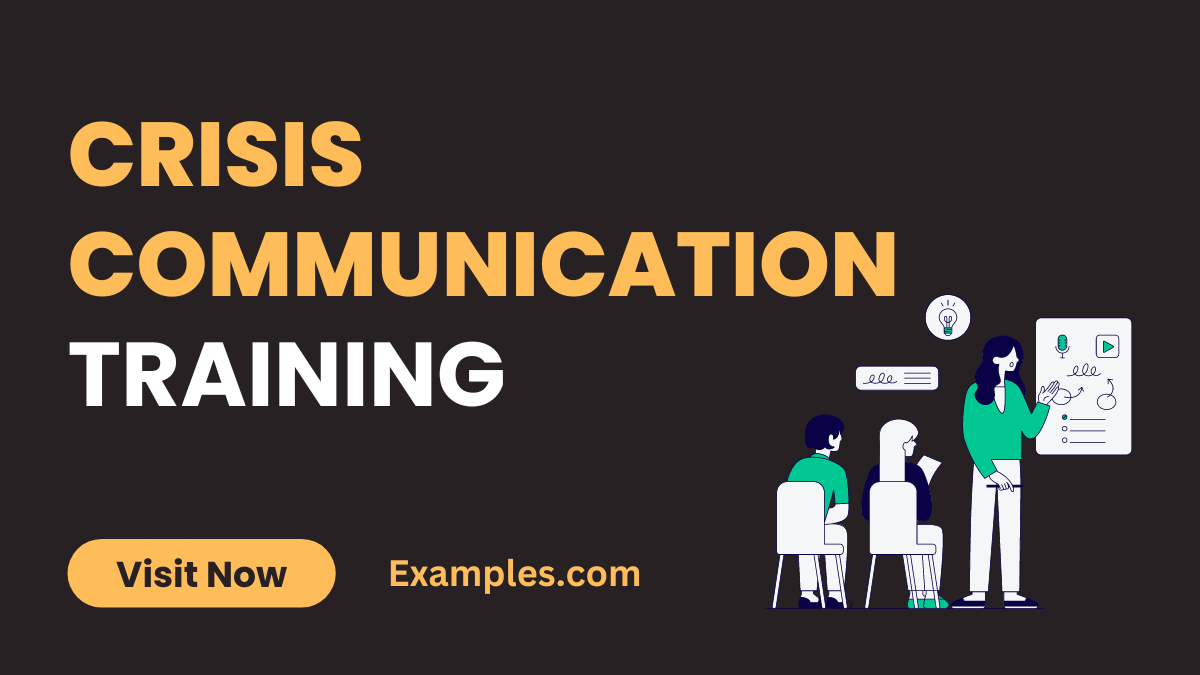19+ Crisis Communication Training Examples
Embark on a journey into the realm of Crisis Communication Training as we unravel its Definition, Examples, Origin, History, How-to, and Tips. In today’s fast-paced world, mastering crisis communication is paramount. Explore the roots and evolution of this crucial skill set, understand its historical context, and grasp essential tips on navigating tumultuous scenarios. Whether you’re a novice or a seasoned professional, this guide is your compass to navigate the intricacies of Crisis Communication with confidence and strategic finesse.
What is Crisis Communication Training?

Crisis Communication Training is a structured process designed to equip individuals and teams with the skills necessary to effectively manage and respond to challenging situations. In simple terms, it is a proactive approach aimed at preparing individuals for potential crises in the workplace. This training involves imparting strategies, techniques, and communication tools to ensure a swift and appropriate response during emergencies. The goal is to empower participants to navigate crises confidently, fostering resilience and maintaining trust in the face of adversity.
20 Examples of Crisis Communication Training

Crisis Communication Training in this comprehensive guide. From clear communication strategies to navigating social media crises, each example unveils a facet of crisis preparedness. Delve into this diverse compilation for insights that go beyond theory, providing actionable takeaways for your training endeavors.
- Tabletop Exercises: Simulated scenarios where teams strategize responses to various crises, fostering quick thinking.
- Media Interview Simulation: Training individuals to handle interviews during sensitive situations, ensuring a poised and controlled demeanor.
- Emergency Response Drills: Practicing swift communication in real-time during workplace emergencies like fire or natural disasters.
- Social Media Crisis Management: Navigating and responding to negative online sentiment effectively to protect brand reputation.
- Product Recall Scenario: Preparing for and managing communication during a product recall to minimize fallout.
- Leadership Messaging: Training leaders to convey empathy, reassurance, and clarity during a crisis.
- Customer Complaints Handling: Addressing customer concerns promptly and professionally to maintain trust.
- Rumors and Misinformation Exercise: Dealing with false information by correcting inaccuracies and managing public perception.
- Cybersecurity Breach Simulation: Communicating transparently about a data breach while minimizing panic.
- Employee Termination Communication: Handling internal communication with sensitivity during workforce changes.
- Natural Disaster Response: Coordinating communication efforts in the aftermath of natural disasters to aid affected stakeholders.
- Legal Crisis Communication: Addressing legal challenges while maintaining public trust and confidence.
- Pandemic Preparedness Training: Developing communication strategies for health crises, such as pandemics.
- Hostile Takeover Communication: Managing internal and external communication during a corporate takeover or merger.
- Environmental Crisis Management: Communicating responsibility and commitment during environmental issues.
- Proactive Reputation Building: Implementing ongoing communication strategies to build a positive public image.
- Protest or Demonstration Communication: Addressing concerns and ensuring safety during public demonstrations or protests.
- Workplace Violence Preparedness: Communicating measures in place and ensuring safety during potential violence incidents.
- Government Relations Crisis: Navigating communication challenges during interactions with regulatory bodies or government agencies.
- Customer Data Breach Communication: Transparently addressing and rectifying customer data breaches to rebuild trust.
Crisis Communication Training for Employees
In today’s dynamic work environment, Crisis Communication Training for employees is not merely a luxury but a strategic necessity. This comprehensive guide delves into the intricacies of cultivating effective communication skills amidst crises, emphasizing their pivotal role in preserving organizational resilience and trust.
Importance of Communication Skills in Crisis Management
Effective crisis communication begins with honing essential communication skills. Whether it’s conveying empathy, maintaining transparency, or ensuring consistent messaging, employees must embody these skills to navigate challenging scenarios successfully.
Crisis Communication Training Strategies
1. Simulated Scenarios: Engage employees in realistic crisis simulations, allowing them to practice their communication skills in a controlled environment.
2. Role-Playing Exercises: Encourage employees to take on different roles to understand varied perspectives, fostering a well-rounded approach to crisis communication.
3. Media Training: Equip employees with media interaction skills, ensuring they can convey messages effectively even under pressure.
Developing Strong Communication Skills
- Continuous Training Programs: Implement ongoing training programs to reinforce and enhance communication skills regularly.
- Feedback Mechanism: Establish a feedback loop where employees receive constructive feedback on their communication performance, facilitating improvement.
- Mentorship and Coaching: Provide mentorship opportunities to help employees learn from experienced communicators within the organization.
Key Components of Employee Crisis Communication Training
- Understanding Organizational Values: Align crisis communication with organizational values to maintain consistency and authenticity.
- Building Trust: Emphasize the role of communication in building and maintaining trust, a cornerstone of successful crisis management.
Measuring Success in Crisis Communication Training
- Evaluation Metrics: Define key performance indicators (KPIs) to assess the effectiveness of employee crisis communication training.
- Post-Training Assessments: Conduct assessments after training sessions to gauge comprehension and skill application.
Challenges and Solutions
- Overcoming Resistance: Address employee resistance by highlighting the tangible benefits of crisis communication training for both individuals and the organization.
- Technology Integration: Leverage technology for virtual training sessions, ensuring accessibility and flexibility for all employees.
Crisis Communication Training at Workplace

In the dynamic landscape of modern workplaces, mastering effective crisis communication skills is imperative. This comprehensive guide delves into the nuances of Crisis Communication Training at the workplace, offering insights, strategies, and actionable tips to empower individuals and teams.
Understanding the Need for Workplace Crisis Communication Training: Effective crisis communication begins with recognizing the importance of fostering clear and concise communication skills within the workplace. Explore the significance of preemptive training to navigate potential crises, ensuring a resilient and well-prepared workforce.
Key Components of Crisis Communication Training: Uncover the essential components of workplace crisis communication training. From honing active listening skills to mastering message consistency, delve into the crucial aspects that contribute to creating a communicatively adept workforce.
Building Strong Communication Foundations: Explore the foundational elements of effective communication within a workplace context. Understand how a robust communication infrastructure contributes to crisis preparedness and ensures a swift and coordinated response during challenging situations.
Integrating Technology and Communication: In the digital age, technology plays a pivotal role in crisis communication. Discover how to leverage communication tools and platforms effectively, ensuring timely and accurate dissemination of information to internal and external stakeholders.
Role of Leadership in Crisis Communication: Examine the critical role leadership plays in crisis communication. Learn how leaders can inspire confidence, provide clear guidance, and foster a culture of transparency, contributing to the overall success of crisis communication initiatives.
Developing Empathy in Communication: Explore the importance of empathy in crisis communication and how it can be cultivated within the workplace. Understand how empathetic communication enhances relationships with employees, stakeholders, and the public during times of crisis.
What are the crisis communication planning for training?
In the realm of crisis communication training, effective planning is the linchpin for success. Communication skills play a pivotal role, ensuring a cohesive and strategic response to crises. This guide unveils the intricacies of crisis communication planning, providing a roadmap for honing essential skills.
Understanding the Importance of Communication Skills: The foundation of crisis communication planning rests on the proficiency of communication skills. Recognizing the significance of clear, concise, and empathetic communication is paramount. This section delves into the vital role these skills play in crisis situations and their impact on overall preparedness.
Defining Communication Objectives and Goals: Before embarking on training initiatives, articulate clear communication objectives and goals. Establishing these benchmarks ensures that training efforts align with organizational values and strategic objectives. Learn how to tailor communication goals to various crisis scenarios for maximum effectiveness.
Identifying Key Stakeholders and Audiences: Effective crisis communication extends beyond internal teams. Identifying key stakeholders and target audiences is crucial for tailoring messages to resonate with diverse groups. This section provides insights into audience analysis, helping refine communication strategies for different stakeholders.
Incorporating Rapid Response Strategies: Communication skills shine during rapid response scenarios. Explore strategies for swift and effective responses, emphasizing the importance of real-time communication. Learn how to train teams to convey key messages promptly without compromising accuracy or empathy.
Integrating Technology and Tools: In the digital age, leveraging technology is imperative. Discover the latest communication tools and platforms that enhance crisis communication training. From social media monitoring to internal communication platforms, this section explores how technology can amplify the impact of communication skills.
Conducting Simulated Crisis Scenarios: Hands-on experience is invaluable in crisis communication training. Learn how to design and conduct simulated crisis scenarios that mirror real-world challenges. This immersive approach allows participants to apply and refine their communication skills in a controlled environment.
Evaluating and Iterating Training Programs: Continuous improvement is the hallmark of effective crisis communication planning. Understand the importance of post-training evaluations, feedback loops, and iterative adjustments. This section guides organizations on refining their training programs based on insights gathered from real and simulated scenarios.
How do you develop crisis communication training ?
Effective crisis communication training is pivotal for equipping individuals and teams with the essential skills to navigate challenging situations. Developing a robust training program involves careful planning and consideration. Here’s a step-by-step guide on how to cultivate impactful crisis communication training:
1. Assessment of Organizational Needs: Before crafting your training, assess the specific communication challenges your organization may face during crises. Identify potential scenarios, key stakeholders, and communication gaps.
2. Define Clear Objectives: Clearly outline the objectives of your crisis communication training. Whether it’s enhancing leadership messaging or improving social media management, having specific goals ensures a targeted and effective training program.
3. Tailor Training Content: Customize your training content based on the identified needs and objectives. Develop scenarios and examples that resonate with your industry, ensuring the training is relevant and relatable.
4. Incorporate Communication Styles: Integrate diverse communication styles into your training. Address verbal and non-verbal cues, emphasizing the importance of adaptability in delivering messages effectively across various channels.
5. Utilize Simulation Exercises: Implement realistic simulation exercises to allow participants to practice crisis communication in a controlled environment. These exercises should mimic potential crises, enabling hands-on learning.
In conclusion, Crisis Communication Training is a strategic imperative for any organization, providing the tools and skills necessary to navigate tumultuous scenarios successfully. This comprehensive guide has illuminated the importance, provided impactful examples, and offered a step-by-step approach for effective training. Armed with this knowledge, organizations can cultivate a culture of resilience and adaptability, ensuring steadfast communication in times of crisis.



